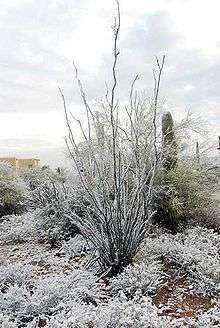Fouquieria splendens
| Fouquieria splendens | |
|---|---|
 | |
| Ocotillo during the monsoon season near Gila Bend, Arizona | |
| Scientific classification | |
| Kingdom: | Plantae |
| (unranked): | Angiosperms |
| (unranked): | Eudicots |
| (unranked): | Asterids |
| Order: | Ericales |
| Family: | Fouquieriaceae |
| Genus: | Fouquieria |
| Species: | F. splendens |
| Binomial name | |
| Fouquieria splendens Engelm. | |
| Synonyms[1] | |
|
Fouquieria spinosa Torr. | |
| Wikimedia Commons has media related to Fouquieria splendens. |
Fouquieria splendens (commonly known as ocotillo American Spanish: [okoˈtiʝo], but also referred to as coachwhip, candlewood, slimwood, desert coral, Jacob's staff, Jacob cactus, and vine cactus) is a plant indigenous to the Sonoran Desert and Chihuahuan Desert in the Southwestern United States (southern California, southern Nevada, Arizona, New Mexico, western Texas), and northern Mexico (as far south as Hidalgo and Guerrero).[2][3]
Ocotillo is not a true cactus. For much of the year, the plant appears to be an arrangement of large spiny dead sticks, although closer examination reveals that the stems are partly green. With rainfall, the plant quickly becomes lush with small (2–4 cm), ovate leaves, which may remain for weeks or even months.
Individual stems may reach a diameter of 5 cm at the base, and the plant may grow to a height of 10 m (33 ft). The plant branches very heavily at its base, but above that, the branches are pole-like and rarely divide further, and specimens in cultivation may not exhibit any secondary branches. The leaf stalks harden into blunt spines, and new leaves sprout from the base of the spine.
The bright crimson flowers appear especially after rainfall in spring, summer, and occasionally fall. Flowers are clustered indeterminately at the tips of each mature stem. Individual flowers are mildly zygomorphic and are pollinated by hummingbirds and native carpenter bees.
Cultivation
Planting ocotillo can be done year-around with care. Ideal plants have been grown from stem cuttings and from seed. Transplanting large bare-root plants has marginal success. They should be planted to the original growing depth and, as with cacti, in their original directional orientation: the original south side of the plant, which has become more heat- and sunlight-resistant, should again face the brighter, hotter southern direction. If their direction is not marked, success is again limited.
Ocotillo plants prefer well-drained, sandy or gravely loam soil with low to moderate amounts of organic content. Ideal locations are sunny, open, unrestricted and those where surface water does not collect. Transplanted plants require irrigation to become established, but once established, they can survive on 8 inches of rainfall per year.
Uses
- Individual ocotillo stems are sometimes used as poles as a fencing material in their native region, and often take root to form a living fence.
- Due to their light weight and interesting pattern, ocotillo branches have been used for canes or walking sticks.
- Fresh flowers are sometimes used in salads and have a tangy flavor.
- Flowers are collected, dried, and used for tisanes.
- According to Medicinal Plants of the Desert and Canyon West (a book published in 1989 by Museum of New Mexico Press), a fresh bark tincture can be made by chopping or snipping freshly removed bark into 1/2-inch pieces. It is said to be useful for those symptoms that arise due to fluid congestion and to be absorbed from the intestines into the mesenteric lymph system by way of the lacteals of the small intestinal lining. This is believed to stimulate better visceral lymph drainage into the thoracic duct and improve dietary fat absorption into the lymph system.[4]
- Bathing in water that contains crushed flowers or roots has been used to relieve fatigue.[4]
- Native Americans are known to place the flowers and roots of ocotillo over fresh wounds to slow bleeding.[4]
- Ocotillo is also used to alleviate coughing, achy limbs, varicose veins, urinary tract infections, cervical varicosities, and benign prostate growths.[4]
Subspecies
The three subspecies are:
Gallery
 Octotillo forest in the Santa Rita Mountains of Arizona
Octotillo forest in the Santa Rita Mountains of Arizona Closeup of ocotillo leaves
Closeup of ocotillo leaves- Closeup of ocotillo thorns in Anza-Borrego Desert State Park
- Closeup of ocotillo flowers in Anza-Borrego Desert State Park
 Ocotillo covered with rare snow in Tucson, Arizona
Ocotillo covered with rare snow in Tucson, Arizona Ocotillo in full bloom near Lookout Mountain, Phoenix, Arizona
Ocotillo in full bloom near Lookout Mountain, Phoenix, Arizona Ocotillo flower with a bee above — Tucson
Ocotillo flower with a bee above — Tucson- Ocotillo with leaves outside Tucson Mountains after a rainfall event
 Ocotillo plant in Joshua Tree National Park
Ocotillo plant in Joshua Tree National Park
See also
- Big Bend National Park
- Chihuahuan Desert
- Guadalupe Mountains National Park
- McKittrick Canyon
- Sonoran Desert
References
- ↑ The Plant List, Fouquieria splendens Engelm.
- ↑ Biota of North America Program 2014 county distribution map
- ↑ McVaugh, R. 2001. Ochnaceae to Loasaceae. 3: 9–751. In R. McVaugh (ed.) Flora Novo-Galiciana. The University of Michigan, Ann Arbor
- 1 2 3 4 Maya Strunk (Spring 2001 Independent study) at Medicinal Plants of the Southwest
External links
- Calflora Database: Fouquieria splendens (Ocotillo)
- Jepson Manual eFlora (TJM2) treatment of Fouquiera splendens
- USDA Plants Profile for Fouquieria splendens (ocotillo)
- Encyclopedia of Life.org: Fouquieria splendens
- Ocotillo (Fouquieria splendens) in Joshua Tree National Park
- UC CalPhotos gallery of Fouquieria splendens
